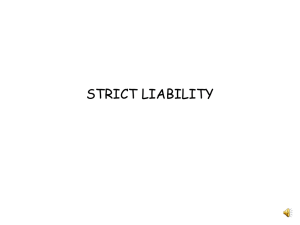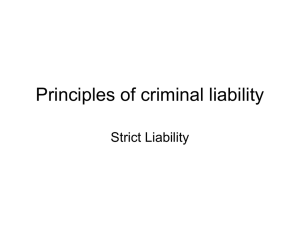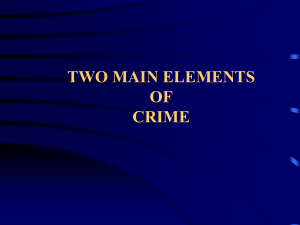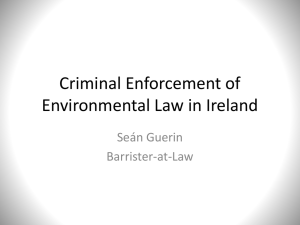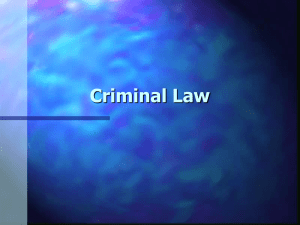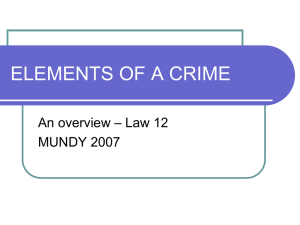LAW OF Criminal Liability
advertisement
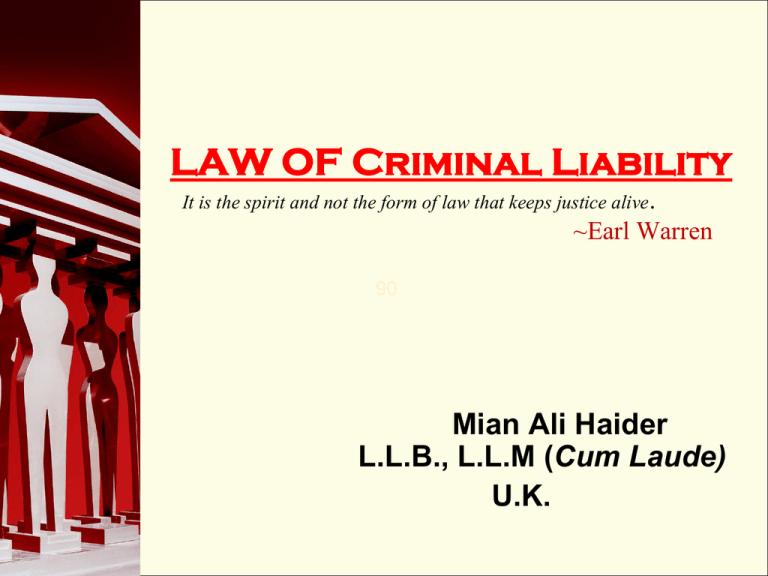
LAW OF Criminal Liability It is the spirit and not the form of law that keeps justice alive. ~Earl Warren 90 Mian Ali Haider L.L.B., L.L.M (Cum Laude) U.K. HISTORICAL CONTEXT • Criminal liability attaches to the commission of a prohibited consequence with a particular mental state. • In addition to laws creating offences themselves, laws 90of criminal liability specify how and in what circumstances responsibility attaches to the commission of an offence. • Laws of criminal liability are not offences in themselves, but underlie the interpretation and application of specific offences in criminal trials. HISTORICAL CONTEXT • The development of legislation as the dominant criminal and regulatory framework has seen issues of criminal liability arise out of the ambiguous or inconsistent language used to construct statutory offences. 90 • Statutes pose problems because they do not always structure criminal liability in terms of prohibited consequences and mental states, and depart from the recognised structure of criminal liability at common law. HISTORICAL CONTEXT • By the mid 19th century, offences were increasingly defined by statute. • For the past century, Pakistani and most of the criminal law has become decreasingly reliant on the common law. 90 • Many offences have been created without a component of mens rea (eg, exceeding a speed limitation). • However, delimiting offences that do not require mens rea from those that do can be problematic. 1st Division Of Crime • Three main structures of criminal liability are presently recognised by the Pakistani criminal legal tradition. The tripartite division of crimes: • CRIMES OF MENS REA • Defined by reference90to consequences and subjective mental standards • The accused cannot be convicted unless they possess the required mental state (eg, intention or recklessness for murder) or some substitute for it (eg, constructive murder) 2nd Division Of Crime • CRIMES OF STRICT LIABILITY – Defined by reference to the doing of the prohibited conduct or the causing of the prohibited consequences – Prima facie, criminal liability attaches proof that the actus reus has been committed (ie, voluntarily) • The prosecution need not prove fault Only the physical elements of the crime are necessary to prove • A GENERAL DEFENCE EXISTS: 90 • Honest and reasonable mistake of fact is legally available • • to the accused Where the accused is labouring under an honest and reasonable mistake of fact as to circumstances which, if they existed, would have meant no offence was committed, the accused will not be guilty of the offence The onus is on the defence to raise sufficient evidence to be considered relevant; having done so, the onus shifts to the prosecution to disprove the defence beyond reasonable doubt 3rd DIVISION OF CRIME CRIMES OF ABSOLUTE LIABILITY – Defined by reference to the doing of the prohibited conduct or the causing of the prohibited consequences – The conduct or consequences in and of themselves create criminal liability Of course, the accused can still raise arguments to defeat the actus reus Eg, involuntariness, 90 duress, etc • NO DEFENCE of honest and reasonable mistake of fact applies – Because of the relative ease with which criminal liability attaches to conduct, these offences are rare THEORETICAL ANALYSIS SEVERAL POLICY ARGUMENTS EXIST IN FAVOUR OF THE CREATION OF OFFENCES OF STRICT AND ABSOLUTE LIABILITY: – The penalties imposed by such offences are not that severe, so it is an acceptable way to regulate social conduct – The conduct constituting the actus reus must obviously be voluntary; however,90 dispensing with mens rea means minimum standards of behaviour can be easily imposed and enforced on thoughtless (or resourceful) individuals – Justifiable to presume fault: regulatory offences need to set minimum standards for the common good – Prosecutions under strict liability offences are simplified and more efficient, particularly where they are relatively minor – It can often be difficult to prove a mental state of knowledge of intention; without strict liability crimes, many offenders would go unpunished THEORETICAL ANALYSIS COUNTER-ARGUMENTS ARE ALSO ABLE TO BE FORMULATED: – The common law is supposed to punish moral blameworthiness, so punishing conduct alone will corrupt the moral authority of the criminal law 90 be based on culpable conduct (not – Criminal liability should conduct per se) – Rebuttal: someone can still be culpable in being careless of thoughtless (ie, not possessing recognised mens rea) – less culpable, perhaps, but still meriting punishment – It is better that evil should go unpunished than the morally innocent should suffer – Balancing competing considerations of justice can be a difficult normative (and regulatory/legal) exercise THEORETICAL ANALYSIS • It is rare for statutes to expressly state the kind of liability being imposed. THIS IS PARTLY BECAUSE – legislators don’t categorise offences in the same way as judges and lawyers, and partly because it is presumed that interpretation should ultimately be left to the courts. Arguably, courts are unsuited to this task: 90 – Courts are reactive (depend on parties to bring a matter before them) – Decision-making is ad hoc (any interpretation would occur in the context of a given case – and not universally) – The kind of interpretation being urged by legislators is activist (courts should apply law, not unnecessarily create it) – Nevertheless, courts remain the principle arbiters of the classification of statutory offences into the categories of mens rea, strict and absolute liability CURRENT POSITION • Any classification of a criminal offence should begin with the statutory section that provides its definition. • In particular, the section should be examined with a view to identifying references to mental states inherent in: – ELEMENTS OF THE 90 CRIME; – THE DEFENCES THAT ARE AVAILABLE, IF ANY; – THE WORDS IN WHICH THE SECTION IS PHRASED. • If the statutory section explicitly requires or excludes a specific mental element or defence, then the interpretation of the statutory section ends here, and it is to be presumed that the crime created is one of mens rea. CURRENT POSITION • If the statutory section is ambiguous (or, as is more usually the case, silent) concerning any requirement of mens rea, then the common law imposes a presumption of mens rea. This presumption is strong and will not lightly be displaced: “There is a presumption that mens rea, an evil 90 intention, or a knowledge of the wrongfulness of the act, is an essential ingredient of every offence, but that presumption is liable to be displaced either by the words of the statute creating the offence or by the subject matter with which it deals, and both must be considered”. (Sherras v de Rutzen (1895) UK per Wright J) INTERPRETATIVE CRITERIA • A court will have regard to several criteria in determining whether a crime defined by statute is one of mens rea, strict or absolute liability: – The language of the section creating the offence (and relatedly, the context and – History of the statute) – The subject-matter of90the statute – The seriousness of the consequences for the community of the commission of such crimes – The seriousness of the consequences for the individual of potential conviction • Whether or not the strong presumption in favour of a requirement of mens rea is displaced is determined by reference to these interpretive criteria, which are said to help in identifying the purpose for which the legislature enacted the prohibition. INTERPRETATIVE CRITERIA Several arguments are commonly put forward in relation to the criteria: – The capacity of the individual to do anything to observe the law (if they were unable to act differently, the offence is less likely to be one of strict of absolute liability) – The ‘truly criminal’ nature of the crime created (if a stigma attaches to conviction, the offence is more likely to require mens rea) 90 – The ease or difficulty with which the section can be enforced (if adducing evidence of the accused’s mental state would be difficult, the offence is less likely to require mens rea) – The seriousness of the penalty (the more severe the penalty, the more likely it is that mens rea is required) – The seriousness of the conduct in society (the greater the social problem posed by the conduct of individuals like the accused, the more likely it is that the offence imposes strict or absolutely liability – presumably, in the hope of preventing or stemming the social problem) INTERPRETATIVE CRITERIA • If the strong presumption of mens rea is displaced, then the statutory section does not create a mens rea crime. • A further question which arises – whether the crime created is one of strict or absolute liability – is resolved by reference to the same criteria. This is a ‘weak presumption’. • If the weak presumption of strict liability is not displaced, then the offence is one of strict liability (to which, as a matter of law, the defence of mistake applies). The prosecution must prove that: 90 – The accused did the prohibited act or caused the prohibited consequence; and – The defence of honest and reasonable mistake of fact is not available, because either – (a) the defence is excluded by the terms of the statute; (b) the defence is not so excluded but, on the facts, the accused did not honestly hold the belief; or (c) the defence is not so excluded and the belief was honestly held but, on the facts, the belief was not reasonable; and INTERPRETATIVE CRITERIA • The accused did the prohibited act or caused the prohibited consequence with the required mental element if any is required by the statutory language Eg, if the section requires knowledge of a fact or circumstance (drug importation cases) • However, if the presumption is displaced, then the 90 liability. crime imposes absolute PROSECUTION MUST ONLY PROVE THAT:• – The accused committed the prohibited act or caused the prohibited consequence; and – No defences created by the terms of the statute are available – The extent to which the prosecution will be able to prove these matters depends on the – Availability and admissibility of relevant evidence and its treatment by the jury. THE DOCTRINE OF MISTAKE • It becomes necessary to distinguish between two kinds of mistake: – Mistake of fact (such as to negate mens rea in a relevant crime); and – Honest and reasonable mistake of fact (in the context of a strict liability offence). • Mistake in the context of90 a mens rea crime is not a defence; • It may only be relevant to negative the mental elements of the offence itself. – For example, in the context of theft (or even murder – ‘I thought the gun was unloaded’), a mistaken belief in a legal right may be such as to negate the element of dishonesty. THE DOCTRINE OF MISTAKE • Where a mistake is sought to be relied upon as the basis for a defence of honest and reasonable mistake of fact, the following questions need be asked and answered in the affirmative for it to be available: • As a matter of law, is the defence available in respect of the offence charged? – Is the relevant offence an offence of strict liability for which the defence of honest and reasonable mistake of fact is available? • If the defence is available 90 as a matter of law, did the accused make a mistake of fact (and not a mistake of law)? – Ignorance of the law is no excuse, and such a mistake cannot negative liability • Given that the defence is available and the mistake is as to facts, would the facts being such as the accused mistakenly believed them to be render the accused innocent? • If they would, did the accused honestly and reasonably believe that the facts existed, albeit that the accused was mistaken? THE DOCTRINE OF MISTAKE • If the defence is available as a matter of law, and if the answer to the remaining questions is ‘yes’, then the accused is not guilty of the offence charged • If a mistake is raised in the form of a defence to a charge carrying strict liability, the procedural effect differs substantially from its operation when attempting to negate the mental element of a crime of mens rea: 90 • If honest and reasonable mistake of fact is raised as a defence to a crime of strict liability, the onus rests on the accused to satisfy an evidentiary burden – Where an offence requires mens rea, the onus is on the prosecution to prove intention, knowledge, recklessness, or even negligence – The evidentiary onus is there on the prosecution to prove every element of an offence THE DOCTRINE OF MISTAKE • Where raised as a defence to a crime of strict liability, a mistake must be both honest and reasonable – A mistake raised to negate the mens rea element of an offence need only be honest; it need not also be reasonable – However, if the relevant mental standard is criminal 90 negligence, the reasonableness of a mistake may influence whether it is operative • A mistake used as the basis for a defence of honest and reasonable mistake of fact can only be operative if the mistake pertains to fact – Where mistake is used to negate mens rea, the mistake can be of any kind – That is, it can be in respect of both fact and law
